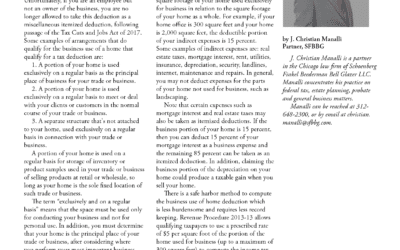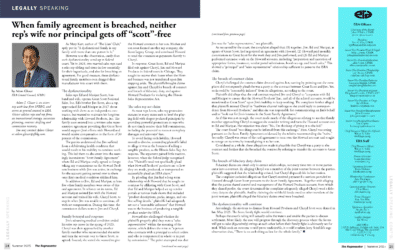Most readers will remember the saga of Broadway Bank and its demise in early 2010 under the hand of the Giannoulias family. The public airing of the bank’s dirty laundry not only sank Alexi Giannoulias’ U.S. Senate bid that November, but inevitably spawned litigation that continues today in Chicago federal court.
While much of this litigation involves arcane issues of banking law, U.S. District Judge John F. Grady just issued an opinion containing useful guidance on questions commonly arising in modern discovery disputes involving voluminous document productions.
Recurrent discovery issues in electronically stored information (ESI) disputes, such as formulating search terms; which the party bears the burden of filtering out unresponsive documents; and in what form the responsive materials must be produced were all addressed by Grady in FDIC v. Giannoulias, No. 12 C 1665 (N.D. Ill. Oct. 23, 2013).
After regulators closed Broadway Bank and the FDIC took it over, the agency initiated suit to recover about $114 million in losses suffered on some 20 commercial real estate loans. The defendants, the bank’s former managing executives charged with negligently approving those loans, served the FDIC with 242 requests for production.
The first phase of the FDIC’s response, where the parties agreed upon a list of unique search terms for the bank’s ESI, led to the production of 500,000 documents, including the complete loan files for the 20 real estate loans. This went relatively smoothly. These were evidently the documents the FDIC could readily identify as responsive to the defendants’ requests.
Disputed search terms
The FDIC objected to adding six additional search terms that would yield an additional 16,800 ESI hits. Four of the proposed terms contained the names of the bank’s outside auditors, and the court quickly determined these terms may capture highly relevant documents concerning the defendants’ management activities.
The court acknowledged the FDIC’s concern that employing these terms would also identify irrelevant or cumulative materials, but the relatively small number of hits involved rendered this unpersuasive.
Grady also ordered the FDIC’s search to include the individual who brokered many of the loans at issue. Where the FDIC had likewise requested broad information from the defendants involving this broker, turnabout was fair play.
However, the defendants’ request to use the search terms “Capitalized” and “Capitalization” was overinclusive. These terms produced a large number of hits and the court found searching for such commonly used banking terms was likely to identify many irrelevant documents.
Burden of producing only responsive materials
Unlike the typical discovery fight, where each side vigorously protects its right to make responsiveness determinations, neither party in this case was anxious to accept the burden of inspecting Broadway Bank’s voluminous documents to ferret out the responsive information.
The FDIC applied the agreed search terms and stood ready to produce the matching documents. Evidently viewing this as a document dump, the defendants called upon the FDIC to inspect those documents in order to produce only those actually responsive.
The court took a practical approach. Careful not to criticize the sizeable scope of the discovery requests in light of the complaint alleging “a broad failure by the defendants to properly manage the bank’s financial risks across 20 loans,” the court felt “the vast majority of the material” would prove responsive to the defendants’ 242 production requests. While some false hits were inevitable, “we will not require the FDIC to review thousands of documents to weed out a presumably small subset of irrelevant materials.”
Organizing the production
Once responsiveness was determined, the FDIC was ready to make production. The defendants, however, invoked Fed.R.Civ.P. 34’s familiar requirement that parties “must produce documents as they are kept in the usual course of business or must organize and label them to correspond to the categories in the request” to insist the FDIC categorize its production to their 242 requests.
Rather than invest the time to match up documents with often overlapping categories in productions requests, the parties commonly comply with this requirement by producing documents as maintained by their clients in the usual course of business. The FDIC attempted its own version of this practice and met a stiff challenge.
E-mails were the main focus of the parties’ dispute and the FDIC was prepared to produce these e-mails from the database it created to store the bank’s documents in a searchable form. The defendants claimed this fell short of Rule 34’s requirement to preserve the documents just as the bank maintained them before it closed, but the court viewed this interpretation as “overly technical.”
Refusing to require the FDIC to organize its production “according to the defendants’ numerous discovery requests,” the court appeared to find the rule’s “usual course of business” standard was satisfied by sorting e-mails chronologically by custodian and enabling the production to be searched using metadata. The burden to the FDIC of strictly enforcing the “usual course of business” production standard was duly considered and helped lead the court to find “the practical difference is elusive.”
Notably, the court felt the risk that important documents might “be obscured (deliberately or inadvertently)” in the FDIC’s method of production was limited by the defendants’ status as former bank managers who “are arguably more familiar with the documents than the FDIC.”
This seems to create an unusual protocol by enabling the FDIC to rely on its litigation opponent to ensure its production is complete, rather than ensure its own compliance. Yet, this again appears to represent a practical approach by Grady to minimize cost and inconvenience.
No discovery dispute is complete without bickering over who bears the cost of production and Grady’s opinion ends by resolving the costs issue on the same practical note. The FDIC was ordered to cover its own costs, subject to later consideration of discretionary cost-shifting under Rule 26(c).
Of course, had Broadway Bank’s executives adopted a comparably practical approach to banking, instead of showing “disregard for risk and a willingness to lend millions of dollars to un-creditworthy borrowers for speculative commercial building projects,” as alleged by the FDIC, the entire episode would likely have been avoided.



